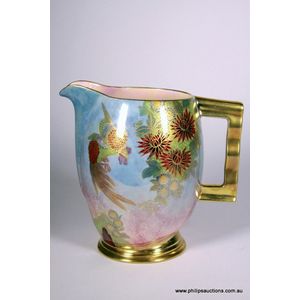Carlton Ware Tiger Tree Jug
You must be a subscriber, and be logged in to view price and dealer details.
Subscribe Now to view actual auction price for this item
When you subscribe, you have the option of setting the currency in which to display prices to $Au, $US, $NZ or Stg.
- Emeralds - Emeralds have been used in jewellery making for thousands of years, and are prized for their deep green colour, which is caused by the presence of chromium and vanadium in the mineral beryl. Because of their rare colour, emeralds are often more valuable than diamonds of a similar size and quality. In jewellery making, emeralds are typically cut into round or oval shapes to maximize their color and clarity. They are often set in gold or platinum and used as the centrepiece of a piece of jewellery, such as a ring or necklace. They can also be used in combination with other gems, such as diamonds, to create intricate and beautiful designs.
- Lustre Ware - Lustre decoration on ceramics is created by painting a thin deposit of metal oxide such as gold, silver or copper onto the surface, and then firing the item again, so that metal oxide forms a thin film on the surface. The finished effect is a shiny metallic surface. The technique was used in the 19th century by potteries such as Crown Devon, Grimwades, Maling, and Royal Doulton. However the best known use was by Wedgwood for its Fairyland lustre.
- Gilding - Gilding is a method of ornamentation whereby a thin sheet of gold metal is applied to items made of wood, leather, ceramics, glass and silver for decorative purposes.
For furniture including mirrors, the sheet of gold is usually applied over a coating of gesso. Gesso is a mixture of plaster of Paris and gypsum mixed with water and then applied to the carved wooden frames of mirrors and picture frames as a base for applying the gold leaf. After numerous coats of gesso have been applied, allowed to dry and then sanded a coat of "bole", a usually red coloured mixture of clay and glue is brushed on and allowed to dry, after which the gold leaf is applied. Over time parts of the gilding will rub off so the base colour can be seen. In water gilding, this was generally a blue colour, while in oil gilding, the under layer was often yellow. In Victorian times, gilders frequently used red as a pigment beneath the gold leaf.
Metal was often gilded by a process known as fire gilding. Gold mixed with mercury was applied and heated, causing the mercury to evaporate, the long-term effect of which was to kill or disable the craftsman or woman from mercury poisoning. The pursuit of beauty has claimed many victims, not the least of which were the artists who made those pieces so highly sought after today.
This item has been included into following indexes:
- Carlton Ware (England), colourway - Rouge Royale colourway 189
- Carlton Ware (England), item types - jugs and ewers 63
- Carlton Ware (England), patterns
Visually similar items

A Carlton Ware 'Rabbits At Dusk' lustre jug, circa 1938, described on jug as pattern 4247 (pink) but is actually 4249 (mottled orange version) with pattern attributed to Irene Pemberton, the barrel form jug with a bracket handle, decorated in bright green

A Carlton Ware 'Fighting Cocks' jug, 1937-1941 period, pattern 4186, the baluster jug with a bracket gilt handle decorated with fowl in combat between red and blue flowers with emerald and apple green colours embellished with gilded tracery and scrolling p

A Chinese porcelain planter, Neatly painted with figures in overglaze, the rounded body curving out from a flat foot, height 20 cm, diameter 15 cm

Carlton Ware hand enamelled jug. C.1930s English wild flowers & sky. Crazing, wear to handle & enamel loss to flower. Height 17.5 cm
